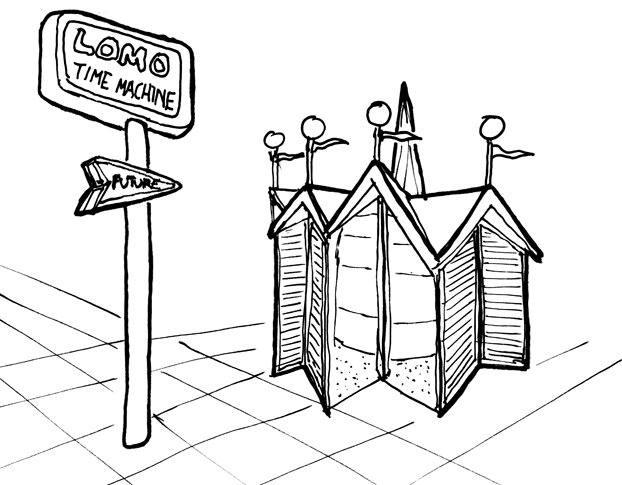Click here for an index of all “Lomo Manifesto” posts.
It was not so long ago that the dominant architectural-historical narrative held that Modernism was dead, succeeded in the evolution of avant-garde movements by something called Postmodernism. During those dark years, the conquering Postmodernist overlords strode the lands like kings. Meanwhile the persecuted Modernists struggled, in many cases committing apostasy and taking up the new faith, while others were forced into the Underground.
Not much later, the tables were turned, and subsequently it is Postmodernism that appears bankrupt. The key works of Postmodern architecture (take Michael Graves’s Portland building – please!) are now primarily hated or ignored by practitioners and ideologists of design. The commonly held perspective of architects today is that Postmodernism was infertile, spawning the most disappointing architectural progeny of the 20th Century and leading to an ideological cul-de-sac. In the oversimplified evolutionary roadway of architectural styles, Postmodernism became a dead-end road; architects have been compelled to go backwards to the main highway of Modernism in order to move forward again.*

The 1989-1993 television series, Quantum Leap, stood as a parable for the disorienting dilemma under which contemporary architects struggled to design Postmodern architecture. In each episode, Scott Bakula’s “Sam Beckett” had the duty of righting the wrongs – he parachuted into some new context, identified the problem to be solved, proceeded to solve it, and then got out. Just as the Postmodern practitioner concealed his or her secret Modernist ethical codes while designing historical re-enactment architecture, no matter what historical or social context in which he discovered himself, Sam could never reveal that actually he came from the future and saw Scott Bakula when he looked in the mirror. Meanwhile, Sam’s “swiss-cheesed brain” struggled to recall fuzzy memories of the futuristic world that he willingly abandonded. Unable to reveal his true persona to his associates, Sam was obliged to embrace the role and historical context given him. As soon as Sam succeeded at convincing his collaborators that he was Authentic, he abandoned them, leaping to the next project. Dean Stockwell’s “Al Calavicci” fulfilled the role of Sam’s super-ego. Al was an invisible conscience that only he could perceive, impressing upon Sam his sense of ironic detachment, a parallel for the exclusive language and code of ethics that only architects can understand.

Just as Sam Beckett hopes each time that his next leap will be the leap home, the Postmodern architect’s existential crisis of meaninglessness could only be solved by returning back home to the ethics and ideals of Modernism. And from that point of regression, it is through the Lower Modernisms in particular that the path of future development continues. Lomo commercial projects provide valuable precedents for a post-Postmodernism, as they presaged both the historical references and the humor of the best Pomo architecture, but without the ponderous elitism. Furthermore, the Lomo solutions become ever more relevant as the profession, especially in the United States, transitions toward a relatively impoverished architecture of low budgets, restricted options, strict entitlements, and limited resources.
Notes.
* I cannot help but share this perspective, short-sighted by its own set of prejudices, even though it seems increasingly obvious that a re-evaluation of the Postmodernist architecture of the 1980s and 1990s is already happening and about to bust into the mainstream. A renaissance of Postmodernism, presumably starting with a critical reconsideration of its theoretical merits to be followed shortly afterward by a wave of nostalgia for its stylistic qualities, is as inevitable and predictable as the impending tidal wave of nostalgia for music, fashion, and popular culture of the 1990s. I cannot yet imagine what this will look like even though we all know it is coming, but this is the time to strategize how to get out to the front of the Pomo Revival. These two blog posts are part of my effort to grapple with the beast.
Leave a Reply